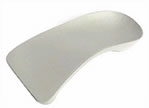| How custom-orthotics
are made at FootWise
The Initial Consultation
If during your initial consultation, your
podiatrist recognises that orthotics will be of benefit
to your foot problem, your podiatrist will perform a
biomechanical examination of the foot and lower extremity.
A standing and walking gait analysis with
a video and treadmill and/or a computerised walk analysis
system will be performed to establish any abnormal function,
then angle measurements of the foot and the ankle are
taken to determine the functional deformities and the
necessary correction.
You may then book a plaster or foam casting
consultation, where the podiatrist will then make a
3-dimensional model of the patient’s feet. This
can be either a plaster cast or a compressible foam
cast of the feet. This model of the foot, together with
the results of the biomechanical examination, is used
to manufacture the custom-made insoles (prescription
orthotics).
The Plaster or Foam
Casting Consultation
This plaster cast (or foam
cast) will be used to create a pair of orthotics that
will balance and correct your feet precisely according
to your foot type, walking tendencies, joint misalignments
and all other related foot conditions.
The whole process
last about 30 minutes, and you will be lying on your
belly the whole time.

Your podiatrist
will begin by holding your foot in a specific "neutral"
position, and he will then wrap wide plaster bandages
around your foot. After a few minutes, when the plaster
is just about hard, your podiatrist will pull the first
plaster cast off your foot, and start the same process
with your other foot.
The Making
of the Orthotics
 The
two casts (now dry and hard) will be sent to a lab where
the plastic orthotics are custom-made according to the
shape of the casts and according to specific instructions
and measurements given by your podiatrist to "counter-effect"
the detrimental position of your feet's joints. The
two casts (now dry and hard) will be sent to a lab where
the plastic orthotics are custom-made according to the
shape of the casts and according to specific instructions
and measurements given by your podiatrist to "counter-effect"
the detrimental position of your feet's joints.
In the lab, the casts of your feet are
digitally scanned into the computer, the information
regarding the podiatrist’s prescription is added
to create the design of your individual orthotics. All
that digital data is then downloaded to the computerised
milling machine which carves out your orthotics from
a solid block of high-density Polystone PP within 5
microns of accuracy. Excess material is then grinded
off and the orthotics are then quality controlled.
The Fitting Consultation: How
to Wear the Orthotics
Your orthotics will then be fitted by
your FootWise Podiatrist. During this consultation,
he may make minor adjustments to improve shoe fit. It
is therefore important you come to that consultation
with the shoes in which you intend wearing your orthotics
most.
You will find the orthotics very comfortable
to wear as they have been custom-made to your foot.
But because your posture will have been corrected by
the orthotics, you may find it “weird” walking
with the orthotics in your shoes in the beginning. Your
muscles and ligaments need to get used to working in
new positions, and this adaptation needs to be gradual
in order to be smooth: the first day only wear the orthotics
during 1 hour, and each day increase the wearing time
by another hour until you are wearing the orthotics
at least 75% of the day. Do not use the orthotics for
sport for the first 2 weeks since sport places your
feet, legs and back under greater stress.
The Review Consultations: Checking
Everything's Going Fine
After 2 weeks you should be wearing your
orthotics “full-time” and should then see
your FootWise Podiatrist again for a 1st review consultation
to assess your orthotics and ensure that they are functioning
correctly.
One month later, a 2nd and last review
consultation should be attended to check everything.
After that, a yearly review is recommended especially
for adults and growing children. For adults, the yearly
review is recommended because ageing, gaining weight
and other factors may warrant minor changes to the orthotics.
For growing children, it is recommended in order to
check that the orthotics are still the correct size.
|


